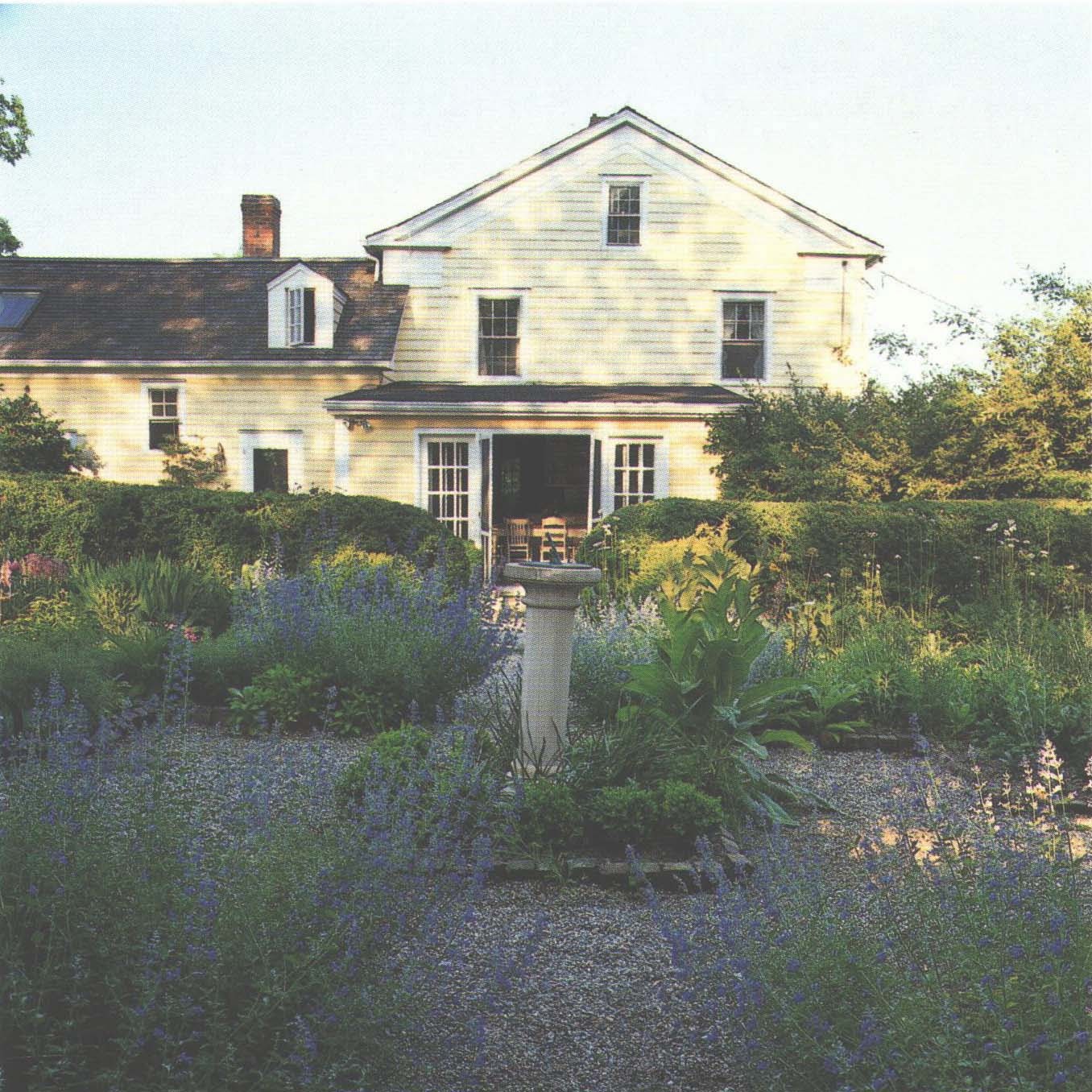"Inside Out" is a garden book of two types: First, the book begins with a short Introduction in which the author relates how her mostly formal gardens are laid out in relation to her small farm house, and provides brief advice about how to achieve this in your own gardens. In addition to half a dozen photos of her lovely house and gardens, she also includes a small map of the layout of her property and its gardens, something that is one of the most helpful aids in describing a garden (but is unfortunately not provided in most garden books). The map shows how her garden areas line up with the sides of her house and the main entrances and windows, which is the major point she is trying to make.
 |
| The view from the author's porch. What lovely crabapple trees! |
 |
| The author's herb garden lines up perfectly with her kitchen door. |
 |
| The garden map of the author's garden, showing how the axes of her garden areas intersect with the doors of her house. And a beautifully drawn map too. |
1. Stand at your windows and think about what you see from them and what you might rather see from them.
2. Stand in your doorways and think about the paths leading to your house and away from it (or plan them logically if they don't exist already).
3. The outlines of garden beds should bear some relation to the footprint of your house.
4. Consider the setting of your house: a house in the country needs a different sort of garden than a house in a small town, a suburban house or a house in a big city.
5. The architectural style of your house (which sometimes is determined by your region, but not always) should play some role determining the style of gardens that are appropriate for your property. A formal, symmetrical house probably needs equally formal gardens (although there is always leeway for romantic plantings within formal beds); a small cottage needs a garden appropriate to that style of house; a modernistic house needs a different garden layout than either of the other two.
6. There are important regional differences in both the styles of gardens and in the types of plants used in each region. Look at which plants are commonly grown in other gardens in your area; these are usually popular because they grow well in your area, and they might also have a traditional historical significance to a region as well. Rather than fighting what is common and trying to be "original" in your plant choices, start with what grows well and looks right in your region, and then experiment with new plants after that.
7. But personal tastes are very important too: grow the kinds of plants you like in the arrangements you like. Some people love cool, green foliage and simple mossy areas; other of us love bright, sunny flowers in abundant cottage gardens; yet others live for the fragrance of plants, or prefer only productive fruits and vegetables for their kitchen. Having an "appropriate" garden is good, but it should also delight you, especially if you plan to live in your house for the long term.
After the author's Introduction, however, the book changes into the second kind of garden book: portraits of 13 very different gardens around the United States in various regional styles. Included are gardens in:
- Connecticut (a weathered New England A-frame house with added screened-in porch and conservatory, surrounded by paved areas and a handsome pergola)
- Arizona (a southwest desert style garden around a modern stucco house),
- two in Illinois (both a formal, old-money garden laid out in the 1920s and a prairie-surrounded house)
- four in New York:
- an artist's billowing farm garden
- a fascinating green garden, clothing the walls of a two-story ruin of an old mansion
- a Manhattan rooftop garden where because of the drying winds, only Zone 4 plants can survive even though Manhattan is in Zone 7
- an architect's upstate New York farmhouse with a classical temple folly

New York garden #2, lush growth filling the
ruins of a long-burnt mansion.
- two in Texas (a boldly-hued, exuberant Texas-style take on Monet's garden and a peaceful Zen retreat of raked gravel and minimalist plantings),
- California (a tiny but lush garden surrounding a San Francisco row house)
- Florida (a jaw-droppingly fabulous oasis of palm trees and other tropical plants surrounding a pool and waterfalls and enveloping a house that opens almost completely to the garden by sliding glass doors on all sides)
- Maine (a perfectly normal white clapboard house appended by a minimally heated greenhouse built of salvaged windows to enclose a mimosa tree with breathtakingly beautiful yellow blooms, an orange tree and other tender plants growing directly in the ground in this Zone 5 location)
 |
| The Florida paradise, as seen from the open walls of the house. This is as fitting to the site as the oval pool is in the Illinois property. |
The properties themselves do illustrate quite well how the gardeners have worked with the sites and regional growing conditions to design gardens that are appropriate for each location, but it's not always obvious what lessons the reader -- especially a beginning gardener reader -- can take away about planning gardens in relation to their own houses.
This was an enjoyable book filled with beautiful garden photos of memorable gardens, but I wish there had been more of the first kind of writing, specific advice about garden design, and less of the second, main, part of the book simply describing gardens. For experienced gardeners, the descriptions will contain lessons about designing gardens, but others may want more explicit advice followed by specific examples.


No comments:
Post a Comment